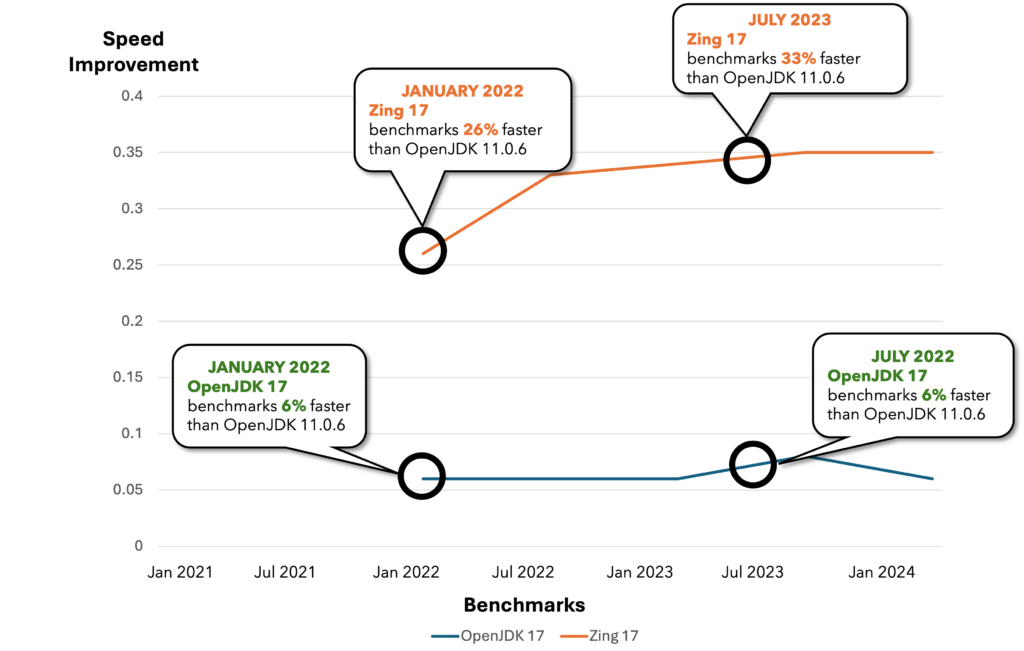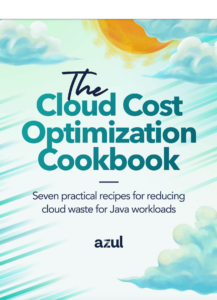
Java is the world’s most popular programming language and development platform for large enterprises because of its flexibility, compatibility, performance, and ease of use.
But well-known issues like slow warmup and stop-the-world garbage collection pauses continue to limit performance. And today companies demand the highest levels of application performance and responsiveness without the need to over-allocate cloud resources. At Azul we removed typical performance barriers with a high-performance Java platform called Azul Platform Prime.
Up to 37% performance improvement for revenue-generating applications
Azul runs benchmarks every quarter against OpenJDK for startup time, warmup time, peak performance, and reliability. The newest round of benchmarks reveals that Azul Platform Prime outperforms traditional OpenJDK by up to 37% with faster warmup and fewer pauses.
Azul achieves these results through its Java Performance Engineering Lab, which collaborates with global Java developers and customers’ technical teams to deliver enhanced Java performance under a strict SLA. The lab measures code optimizations and provides in-depth analysis of performance impacts from new OpenJDK releases.
Recent customer achievements using Azul Platform Prime include:
- Workday – improved its SaaS operational efficiency by 95%, eliminating over 42,000 person hours across an 18-month period. This saved Workday millions of dollars while freeing its developers to do more productive work.
- Global travel technology and distribution platform company – reduced a query application’s response time by 80%, lowered its error rate and eliminated slower and stalled transactions.
- British video game developer – eliminated ticks over 600ms, erasing any pauses a gamer can detect while playing – this improved the platform’s gaming performance by 20% and improved the overall gaming experience.
Why does a high-performance Java platform matter?
Downtime no longer works as a measure of application reliability. Even a slight degradation in performance fails to meet the lofty expectations of today’s enterprises and of their customers.
Enterprises can dramatically improve application performance and responsiveness, increase DevOps productivity, and reduce their cloud compute costs with Azul Platform Prime – without recompiling or changing their application code.
Azul’s high-performance Java platform pushes the limits
For the benchmark data below, we focused on how we maximize performance for Java 17 that was first released in September 2021. Today Java 17 is the most widely deployed Java LTS release used in production environments (source: New Relic). Note that Azul publishes test results for all major Java LTS releases, typically twice a year – January and July.
JDK 17 Performance Comparison Against OpenJDK 11.0.6 Baseline
| OpenJDK | Zing |
|---|---|
| January 2022: out of the gate we found that it was 6% faster compared to our baseline | January 2022: out of the gate we found that it was 26% faster compared to our baseline |
| July 2023: only 2% faster than the January 2022 benchmark | July 2023: Zing 17: additional 25% faster than the January 2022 benchmark |

A peek inside Azul’s Java Performance Engineering Lab
In Azul’s Java Performance Engineering Lab, developers work with our customers’ architects, programmers, and site reliability and performance engineering teams. Together they introduce optimizations that improve Java speed and performance and make client recommendations on how to modernize their own application code, which can result in even further performance gains. The goal of the lab is to identify and produce optimizations for Azul Platform Prime.
Azul’s performance engineers continually test the code speed of OpenJDK distributions, including Azul’s, against accepted industry standard benchmarks such as Rennaissance, DaCapo and SpecJBB, as well as benchmarks for popular Java Apache projects like Kafka, Cassandra and Solr. Each LTS release, quarterly updates of each LTS release, and changes in the software in the security releases will impact Java performance. Azul looks at the performance dependency of these changes.
Azul’s Java Performance Engineering Lab also tests against emerging technologies including:
- New hardware capabilities (e.g. LAM in Intel)
- Updates of CPU architectures (e.g. AWS Graviton 4)
- Latest Linux kernel features, performance tooling
- Progress in Java evolution (e.g. CRaC, Virtual threads, Project Valhalla, Project Leyden)
- Optimizations developed and contributed to the LLVM compiler community
Global FX & crypto marketplace provider boasts 48% faster Java performance
LMAX Group is a global financial technology company and the leading independent operator of multiple institutional execution venues for FX and crypto currency trading. The company processes sustained volumes of 100,000 orders/second capable of bursting to almost a million orders/second per exchange at peak.
LMAX Group and Azul collaborate on performance optimizations, code improvements, and test suites. This cooperation has greatly contributed to the enhancement of LMAX Group’s leading low-latency trade execution capabilities and has enabled the team to focus on innovation to scale rapid growth.
By working with Azul’s experts to improve the performance of their application code and by running their application on Platform Prime, LMAX has achieved 48% faster performance versus running on OpenJDK alone – even faster than Prime’s performance improvement over OpenJDK.

Conclusion
Every Java provider with a marketing department will tell you there’s something special about its Java distribution, but getting them to prove it can be a different story.
With the help of Azul’s Java Performance Engineering Lab, Azul demonstrates superior performance in several ways:
- What you run in production today will run 20% or more faster – without the need to change or recompile your code.
- No matter which Java version you run, you will get immediate performance gains running any LTS since Java 8 without having to upgrade to a new Java version. We continue to work with the Java community to benchmark and increase Zing’s performance to improve how fast your code can go.
- OpenJDK takes a long time to achieve even modest improvements. The velocity of performance improvements in Zing is far superior.
In addition, Azul’s high-performance Java platform uses fewer resources to achieve the same or even greater performance. This efficiency enables organizations to save on infrastructure costs, especially expensive cloud instances. A High-performance Java Platform is one tool in your toolbox for lowering cloud costs. Learn more in Azul’s Cloud Cost Optimization Cookbook, available to read for free on Azul’s website.








